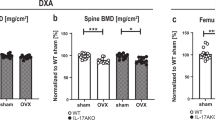Abstract
Pharmacological inhibition of signaling through lysophosphatidic acid (LPA) receptors reduces bone erosions in an experimental model of arthritis by mechanisms involving reduced osteoclast differentiation and bone resorption and increased differentiation of osteoblasts and bone mineralization. These results led us to hypothesize that LPA receptor inhibition would be beneficial in osteoporosis. Our aim was to test this hypothesis with the LPA receptor antagonist, Ki16425, in ovariectomized mice, a model of postmenopausal osteoporosis. Ovariectomized mice treated with Ki16425 showed bone loss similar to that observed in the controls. Osteoblast markers, Alpl, Bglap and Col1a1, were increased at the mRNA level but no changes were detected in serum. No additional difference was observed in the Ki16425-treated mice relative to the ovariectomized controls with regard to osteoclast function markers or assays of matrix mineralization or osteoclast differentiation. Thus, pharmacological inhibition of LPA receptor was not beneficial for preventing bone loss in ovariectomized mice, indicating that its favorable effect on bone remodeling is less general than hypothesized.






Similar content being viewed by others
References
Van Meeteren LA, Moolenaar WH (2007) Regulation and biological activities of the autotoxin-LPA axis. Prog Lipid Res 46:145–160
Orosa B, García S, Martínez P, González A, Gómez-Reino JJ et al (2014) Lysophosphatidic acid receptor inhibition as a new multipronged treatment for rheumatoid arthritis. Ann Rheum Dis 73:298–305
Lapierre DM, Tanabe N, Pereverzev A, Spencer M, Shugg RP et al (2010) Lysophosphatidic acid signals through multiple receptors in osteoclasts to elevate cytosolic calcium concentration, evoke retraction, and promote cell survival. J Biol Chem 285:25792–25801
Boucharaba A, Serre CM, Grès S, Saulnier-Blache JS, Bordet JC et al (2004) Platelet-derived lysophosphatidic acid supports the progression of osteolytic bone metastases in breast cancer. J Clin Invest 114:1714–1725
Boucharaba A, Serre CM, Guglielmi J, Bordet JC, Clézardin P et al (2006) The type 1 lysophosphatidic acid receptor is a target for thearpy in bone metastases. Proc Natl Acad Sci USA 103:9643–9648
Seeman E, Delmas PD (2006) Bone quality––the material and structural basis of bone strength and fragility. N Engl J Med 354:2250–2261
Boyce BF, Rosenberg E, de Papp AE, Duong LT (2012) The osteoclast, bone remodelling and treatment of metabolic bone disease. Eur J Clin Invest 42:1332–1341
Rachner TD, Khosla S, Hofbaner LC (2011) Osteoporosis: now and the future. Lancet 377:1276–1287
Favur MJ (2010) Bisphosphonates for osteoporosis. N Engl J Med 363:2027–2035
Marie PJ, Kassem M (2011) Osteoblasts in osteoporosis: past, emerging, and future anabolic targets. Eur J Endocrinol 165:1–10
Ohta H, Sato K, Murata N, Damirin A, Malchinkhun E et al (2003) Ki16425, a subtype-selective antagonist for EDG-family lysophosphatidic acid receptors. Mol Pharmacol 64:994–1005
Hsiao H-B, Lin H, Wu J-B, Lin WC (2013) Kinsenoside prevents ovariectomy-induced bone loss and suppresses osteoclastogenesis by regulating classical NF-κB pathways. Osteoporos Int 24:1663–1676
Fernández de Castro L, Lozano D, Portal-Núñez S, Maycas M, de la Fuente M et al (2012) Comparison of the skeletal effects induced by daily administration of PTHrP(1–36) and PTHrP (107–139) to ovariectomized mice. J Cell Physiol 227:1752–1760
David M, Wannecq E, Descotes F, Jansen S, Deux B et al (2010) Cancer cell expression of autotaxin controls bone metastasis formation in mouse through lysophosphatidic acid-dependent activation of osteoclasts. PLoS One 5:e9741
Gennero I, Laurencin-Dalicieux S, Conte-Auriol F, Briand-Mésange F, Laurencin D et al (2011) Absence of the lysophosphatidic acid receptor LPA1 results in abnormal bone development and decreased bone mass. Bone 49:395–403
Blackburn J, Mansell JP (2012) The emerging role of lysophosphatidic acid (LPA) in skeletal biology. Bone 50:756–762
Zhao C, Fernandes MJ, Prestwich GD, Di Battista J, Clair T et al (2007) Regulation of lysophosphatidic acid receptor expression and function in human synoviocytes: implications for rheumatoid arthritis? Mol Pharmacol 73:587–600
Orosa B, Gonzalez A, Mera A, Gómez-Reino JJ, Conde C (2012) Lysophosphatidic acid receptor 1 suppression sensitizes rheumatoid fibroblast-like synoviocytes to TNF-induced apoptosis. Arthritis Rheum 64:2460–2470
Walsh NC, Gravallese EM (2010) Bone remodelling in rheumatic disease: a question of balance. Immunol Rev 233:301–312
Braun T, Schett G (2012) Pathways for bone loss in inflammatory disease. Curr Osteoporos Rep 10:101–108
Henriksen K, Bollerslev J, Everts V, Karsdal MA (2011) Osteoclast activity and subtypes as a function of physiology and pathology––implications for future treatments of osteoporosis. Endocr Rev 32:31–63
Schurigt U, Hummel KM, Petrow PK, Gajda M, Stöckigt R et al (2008) Cathepsin K deficiency partially inhibits, but does not prevent, bone destruction in human tumor necrosis factor-transgenic mice. Arthritis Rheum 58:422–434
Ainola M, Valleala H, Nykänen P, Risteli J, Hanemaaijer R et al (2008) Erosive arthritis in a patient with pycnodysostosis: an experiment of nature. Arthritis Rheum 58:3394–33401
Leeming DJ, Koizumi M, Byrjalsen I, Li B, Qvist P et al (2006) The relative use of eight collagenous and noncollagenous markers for diagnosis of skeletal metastases in breast, prostate, or lung cancer patients. Cancer Epidemiol Biomarkers Prev 15:32–38
Koopmans N, de Jong IJ, Breeuwsma AJ, van der Veer E (2007) Serum bone turnover markers (PINP and ICTP) for the early detection of bone metastases in patients with prostate cancer: a longitudinal approach. J Urol 178:849–853
Bone HG, McClung MR, Roux C, Recker RR, Eisman JA et al (2010) Odanacatib, a cathepsin-K inhibitor for osteoporosis: a two-year study in postmenopausal women with low bone density. J Bone Miner Res 25:937–947
Acknowledgments
We thank Dra. M. Jesus Ramirez from Dpto. de Ciencias de la Salud (Universidad de Jaen) and Dra. L.M. Seoane and L. Senin from Instituto de Investigación Sanitaria de Santiago de Compostela (IDIS) for advice with ovariectomy. This work was supported by grant PI11/02197, by RETICS Program, RD08/0075 (RIER), all from Fondo de Investigación Sanitaria, Instituto de Salud Carlos III with participation of FEDER funds (European Union).
Conflict of interest
The authors declare that they have no conflict of interest.
Author information
Authors and Affiliations
Corresponding author
About this article
Cite this article
Orosa, B., Martínez, P., González, A. et al. Effect of lysophosphatidic acid receptor inhibition on bone changes in ovariectomized mice. J Bone Miner Metab 33, 383–391 (2015). https://doi.org/10.1007/s00774-014-0607-5
Received:
Accepted:
Published:
Issue Date:
DOI: https://doi.org/10.1007/s00774-014-0607-5




